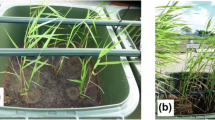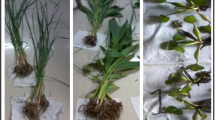Abstract
The present work deals with a promising approach for the removal of heavy metals from secondary treated wastewater using aquatic plants, which are economic and effective in separating metals from polluted water. Since the conventional sewage treatment processes were inefficient to remove heavy metals from wastewater, batch experiments of Phragmites australis, Typha latifolia and P. australis and T. latifolia grown in association and reference (unplanted) were carried out for 15 days of retention time for the removal of copper (Cu), cadmium (Cd), chromium (Cr), nickel (Ni), iron (Fe), lead (Pb), and zinc (Zn) from the secondary treated effluent. Significantly, higher removal of the heavy metals in planted set than the reference revealed role of plants in their removal (analysis of variance, p < 0.05). Higher removal of Cr, Fe, and Zn (66.2 ± 3.5, 70.6 ± 1.2, and 71.6 ± 3.9 %) in the combination of the P. australis and T. latifolia than their individual culture suggested synergistic effect of both the plants in the removal of these metals. Positive relationship was observed between retention time and the removal of heavy metals. Mass balance equation has revealed that the loss of heavy metals in wastewater was equivalent to the net accumulation of heavy metals in plant and loss of heavy metals in natural degradation. P. australis showed higher accumulative capacities for Cu, Cd, Cr, Ni, Fe, and Pb than those of T. latifolia. The P. australis and T. latifolia grown in association might be utilized for the heavy metal removal in the tropical environment.


Similar content being viewed by others
References
Abhilash PC, Pandey VC, Srivastava P, Rakesh PS, Chandran S, Singh N, Thomas AP (2009) Phytofiltration of cadmium from water by Limnocharis flava (L.) Buchenau grown in free-floating culture system. J Hazard Mater 170(2–3):791–797
Allende KL, Fletcher TD, Sun G (2011) Enhancing the removal of arsenic, boron and heavy metals in subsurface flow constructed wetlands using different supporting media. Water Sci Technol 63(11):2612–2618
APHA, AWWA, WEF (2005) Standard methods for the examination of water and wastewater. 21st edn. American Public Health Association/American Water Works Association/Water Environment Federation, USA
Augustynowicz J, Grosick M, Fajerska EH, Lekka M, Waloszek A, Koloczek H (2010) Chromium (VI) bioremediation by aquatic macrophyte Callitriche colphocarpa Sendtn. Chemosphere 79:1077–1083
Aziz HA, Adlan MN, Ariffin KS (2008) Heavy metals (Cd, Pb, Zn, Ni, Cu and Cr(III)) removal from water in Malaysia: post treatment by quality limestone. Bioresour Technol 99(6):1578–1583
Badkoubi A, Ganjidoust H, Ghaderi A, Rajabi A (1998) Performance of a subsurface constructed wetland in Iran. Water Sci Technol 38:345–350
Bonanno G, Giudice RL (2010) Heavy metal bioaccumulation by the organs of Phragmites australis (common reed) and their potential use as contamination indicators. Ecol Indic 10:639–645
Bonano GA (2012) Arundo donax as a potential biomonitor of trace element contamination in water and sediment. Ecotoxicol Environ Saf 80:20–27
Brix H (1994) Functions of macrophytes in constructed wetlands. Water Sci Technol 29(4):71–78
Caselles-Osorio A, Garcia J (2007) Impact of different feeding strategies and plant presence on the performance of shallow horizontal subsurface-flow constructed wetlands. Sci Total Environ 378(3):253–262
Chang JJ, Wu SQ, Dai YR, Liang W, Wu ZB (2012) Treatment performance of integrated vertical-flow constructed wetland plots for domestic wastewater. Ecol Eng 44:152–159
Clevering OA (1999) Between- and within-population differences in Phragmites australis 1. The effects of nutrients on seedling growth. Oecologia 121:447–457
Cohen RRH (2006) Use of microbes for cost reduction of metal removal from metals and mining industry water streams. J Clean Prod 14(12–13):1146–1157
CPCB (1993) General standards for discharge of environmental pollutants. Part A: effluents. Central Pollution Control Board, New Delhi
Cui LH, Zhu XZ, Ouyang Y, Chen Y, Yang FL (2011) Total phosphorous removal from domestic wastewater with Cyperus alternifolius in vertical-flow constructed wetlands at the microcosm level. Int J Phytoremediation 13(7):692–701
Ewan KB, Pamphlett R (1996) Increased inorganic mercury in spinal motor neurons following chelating agents. Neurotoxicology 17:343–349
Fediue E, Erdei L (2002) Physiological and biochemical aspects of cadmium toxicity and protective mechanisms induced in Phragmites australis and Typha latifolia. J Plant Physiol 159:265–271
Ghemandi A, Bixio D, Thoeye C (2007) The role of free water surface constructed wetlands as polishing step in municipal wastewater reclamation and reuse. Sci Total Environ 380(1–3):247–258
Hamouri BEI, Nazih E, Lahjouj J (2007) Subsurface-horizontal flow constructed wetland for sewage treatment under Moroccan climate conditions. Desalination 215:153–158
Hua GF, Li L, Zhao YQ, Zhu W, Shen JQ (2013) An integrated model of substrate clogging in vertical flow constructed wetlands. J Environ Manage 119:67–75
Iannelli MA, Pietrini F, Fiore L, Petrilli L, Massacci A (2002) Antioxidant response to cadmium in Phragmites australis plants. Plant Physiol Biochem 40:977–982
Jacob DL, Otte ML (2004) Influence of Typha latifolia and fertilization as metal mobility in two different Pb-Zn mine tailings types. Sci Total Environ 333:9–24
Kalra YP (1998) Reference methods for plant analysis. CRC Press, Taylor and Francis Group, Boca Raton, FL
Khan S, Ahmad I, Shah MT, Rehman S, Khaliq A (2009) Use of constructed wetland for the removal of heavy metals from industrial wastewater. J Environ Manage 90:3451–3457
Langergraba G (2005) The role of plant uptake on the removal of organic matter and nutrients in subsurface flow constructed wetlands: a simulation study. Water Sci Technol 51(9):213–223
Lyubenova L, Schröder P (2011) Plants for waste water treatment-effects of heavy metals on the detoxification system of Typha latifolia. Bioresour Technol 102(2):996–1004
Maine MA, Suňe N, Hadad H, Sánchez G, Bonetto C (2009) Influence of vegetation on the removal of heavy metals and nutrients in a constructed wetland. J Environ Manage 90:355–363
Marchand L, Mench M, Jacob DL, Otte ML (2010) Metal and metalloid removal in constructed wetlands, with emphasis on the importance of plants and standardized measurements: a review. Environ Pollut 158(12):3447–3461
Mehra A, Farago ME, Banerjee DK (2000) A study of Eichhornia crassipes growing in the overbank and floodplain soils of the river Yamuna in Delhi, India. Environ Monitor Assess 60:25–45
Mench M, Schwitzguébel JP, Schröder P, Bert V, Gawronski S, Gupta S (2009) Assessment of successful experiments and limitations of phytotechnologies: contaminant uptake, detoxification and sequestration, and consequences for food safety. Environ Sci Pollut Res 16:876–900
Miretzky P, Saralegui A, Cirelli AF (2004) Aquatic macrophytes potential for the simultaneous removal of heavy metals (Buenos Aires, Argentina). Chemosphere 57:997–1005
Mishra VK, Tripathi BD (2008) Concurrent removal and accumulation of heavy metals by three aquatic macrophytes. Bioresour Technol 99:7091–7097
Mishra VK, Tripathi BD (2009) Accumulation of chromium and zinc from aqueous solutions using water hyacinth (Eichhornia crassipes). J Hazard Mater 164:1059–1063
Mishra VK, Tripathi BD, Kim KH (2009) Removal and accumulation of mercury by aquatic macrophytes from an open cast coal mine effluent. J Hazard Mater 172:749–754
Moore JW (1990) Inorganic contaminants of surface water research and monitoring priorities. Springer, New York
Ong SA, Uchiyama K, Inadama D, Ishida Y, Yamagiwa K (2010) Performance evaluation of laboratory scale up-flow constructed wetlands with different designs and emergent plants. Bioresour Technol 101(19):7239–7244
Pandey VC (2012) Phytoremediation of heavy metals from fly ash pond by Azolla caroliniana. Ecotoxicol Environ Saf 82:8–12
Rai PK, Tripathi BD (2008) Heavy metals in industrial wastewater, soil and vegetables in Lohta village, India. Toxicol Environ Chem 90(2):247–257
Ranieri E (2012) Chromium and nickel control in full and small-scale sub superficial flow constructed wetlands. Soil Sediment Contam 21(7):802–814
Ranieri E, Paola V, Young TM (2011) Paracetamol removal in subsurface flow constructed wetlands. J Hydrol 404:130–135
Reyes-Contreras C, Hijosa-Valsero M, Sidrach-Cardona R, Bayona JM, Bécares E (2012) Temporal evaluation in PPCP removal from urban wastewater by constructed wetlands by different configuration: a medium-term study. Chemosphere 88(2):161–167
Saeed T, Sun G (2012) A review on nitrogen and organics removal mechanisms in subsurface flow constructed wetlands: dependency on environmental parameters, operating conditions and supporting media. J Environ Manage 112:429–448
Salvato M, Borin M (2010) Effect of different macrophytes in abating nitrogen from a synthetic wastewater. Ecol Eng 36:1222–1231
Sasmaz A, Obek E, Hasar H (2008) The accumulation of heavy metals in Typha latifolia L. grown in a stream carrying secondary effluent. Ecol Eng 33:278–284
Sawidis T, Chettri MK, Zachariadis GA, Stratis JA (1995) Heavy metals in aquatic plants and sediments from water systems in Macedonia, Greece. Ecotoxicol Environ Saf 32:73–80
Sekomo CB, Rousseau DPL, Saleh SA, Lens PNL (2012) Heavy metal removal in duckweed and algae ponds as a polishing step for textile wastewater treatment. Ecol Eng 44:102–110
Tang X, Scholz M, Eke PE, Huang S (2010) Nutrient removal as a function of benzene supply whining vertical-flow constructed wetlands. Environ Technol 31(6):681–691
Tripathi BD, Upadhyay AR (2003) Dairy effluent polishing by aquatic macrophytes. Water Air Soil Poll 43(1–4):377–385
Upadhyay AR, Mishra VK, Pandey SK, Tripathi BD (2007) Biofiltration of secondary treated municipal wastewater in a tropical city. Ecol Eng 30:9–15
Valipour A, Raman VK, Ghole VS (2009) A new approach in wetland systems for domestic wastewater treatment using Phragmites sp. Ecol Eng 35:1797–1803
Vymazal J (2005) Removal of heavy metals in a horizontal sub-surface flow constructed wetland. J Environ Sci Health A Tox Hazard Subst Environ Eng 40(6–7):1369–1379
Vymazal J, Sˇvehla J, Kro¨pfelova′ L, Chrastny′ V (2007) Trace metals in Phragmites australis and Phalaris arundinacea growing in constructed and natural wetlands. Sci Total Environ 380:154-162
Vymazal J, Kro¨pfelova′ L, Sˇvehla J, Chrastny′ V, Sˇ tı′chova J (2009) Trace elements in Phragmites australis growing in constructed wetlands for treatment of municipal wastewater. Ecol Eng 35:303-309
Wen Y, Chen Y, Zheng N, Yang D, Zhou Q (2010) Effects of plant biomass on nitrate removal and transformation of carbon sources in subsurface flow constructed wetlands. Bioresour Technol 101(19):7286–7292
Wojciechowska E, Waara S (2011) Distribution and removal efficiency of heavy metals in two constructed wetlands treating landfill leachate. Water Sci Technol 64(8):1597–1606
Xue PY, Li GX, Liu WJ, Yan CZ (2010) Copper uptake and translocation in a submerged aquatic plant Hydrilla verticillata (Lf.) Royle. Chemosphere 81:1098–1103
Ye ZH, Baker AJM, Wong MH, Wilis AJ (1997) Zinc, lead and cadmium tolerance, uptake and accumulation by the common reed, Phragmites australis (Cav.) Trin. ex. Steudel. Ann Bot 80:363–370
Zhang DQ, Gersberg RM, Hua T, Zhu J, Tuan NA (2012) Pharmaceutical removal in tropical subsurface flow constructed wetlands in varying hydraulic loading rates. Chemosphere 87(3):273–277
Acknowledgments
The authors thank the University Grant Commission (UGC) (Ref. No. Bot./2009-10/Regd.Sept.2009/14/11/09), India, for financial support. The authors are also thankful to the Head, Department of Botany, Banaras Hindu University for providing laboratory facilities.
Author information
Authors and Affiliations
Corresponding author
Rights and permissions
About this article
Cite this article
Kumari, M., Tripathi, B.D. Effect of Phragmites australis and Typha latifolia on biofiltration of heavy metals from secondary treated effluent. Int. J. Environ. Sci. Technol. 12, 1029–1038 (2015). https://doi.org/10.1007/s13762-013-0475-x
Received:
Revised:
Accepted:
Published:
Issue Date:
DOI: https://doi.org/10.1007/s13762-013-0475-x




